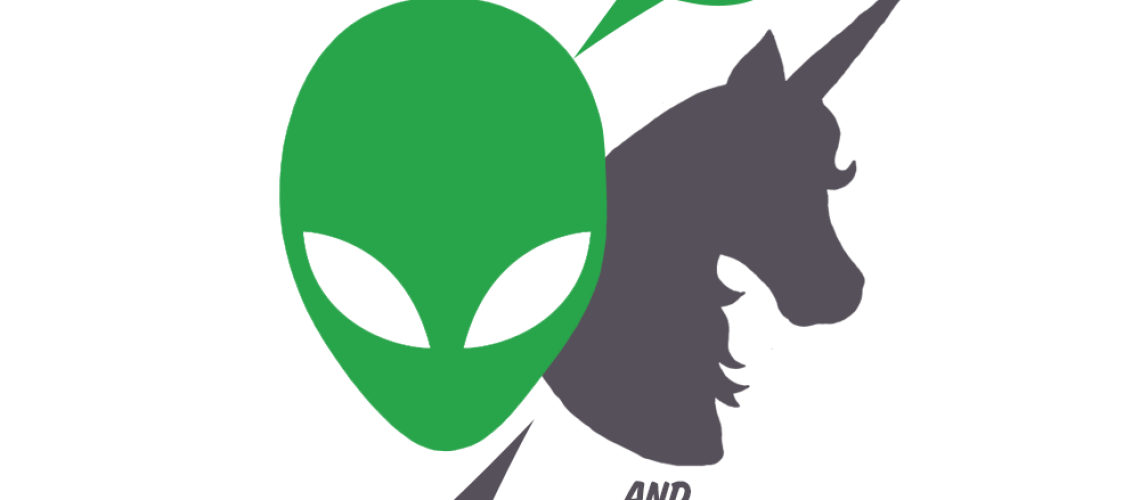The finalists for this year’s Hugo Awards were announced on March 31, and of course I was particularly interested in the Best Graphic Story category.
While none of the works I suggested made it on to the final ballot, I’m very happy with the works that did. There’s a real breadth and diversity of both creators and subject matter that I found deeply heartening to see.
So this month, I’m taking a closer look at each of the six nominees: Bitch Planet Volume 2: President Bitch; Black Bolt, Volume 1: Hard Time; Monstress, Volume 2: The Blood; My Favorite Thing is Monsters; Paper Girls, Volume 3; and Saga, Volume 7.
(These reviews contain spoilers!)

Bitch Planet, Volume 2: President Bitch, written by Kelly Sue DeConnick, illustrated by Valentine De Landro and Taki Soma, colored by Kelly Fitzpatrick, lettered by Clayton Cowles (Image Comics)
In the second volume of Bitch Planet, plans to repurpose the prison-planet into a setting for a violent gladiatorial event/reality show that will further exploit and brutalize the prisoners are underway. But so is inmate Kam’s desperate struggle to find her sister Morowa, who’s being held in another facility elsewhere on the planet. So is architect Mr. Maki’s scheme to travel to the prison to find his imprisoned daughter Meiko, in the guise of building the arena. So are a number of other gambits, all of which collide over the course of President Bitch to blow Bitch Planet, and the regime it’s a tool of, wide open.
I find Bitch Planet hard to read. It’s not that it’s not good. Hell, it’s great. The writing is as sharp and catching as a fishhook, the art evocative. It’s that it’s so very grim. It’s also timely and important — a dystopian hyper-capitalist, beyond-hyper-misogynistic future where “non-compliant” women are sentenced to the titular world, in a sort of Handmaid’s Tale meets women-in-prison exploitation flick meets cyberpunk hellscape? Yeah, unfortunately that remains deeply relevant.
Kelly Sue DeConnick is a startlingly bold writer, unafraid to explore the horrifying implications of her story and its setting. The tension is constant, but changes from scene to scene, from coldly ominous to boiling explosion of rage to deep terror. It’s a window for those of us with more privilege, a hint of what it would feel like to live under constant threat, neverending oppression. Kam in particular is a remarkable protagonist, driven by her experiences to a determination beyond fear, while still being entirely human.
It’s all terrifyingly believable.
It’s not even a flaw, but I’m torn by the decision to open this volume with a flashback chapter that explores a character who died at the end of Volume 1; her life and relationships are vitally important to the story, but it makes for an awkward jumping-on point.
De Landro’s art perfectly conveys the tone of Bitch Planet — of people enduring a cruel regime and its deliberate, casual brutality. The depiction of violence is effective, shocking and frightening, not played for cool or excitement at all. Aptly, the men tend to blend together, by virtue of both their uniforms and their uniformity, while the women are distinct and vibrant, with their personalities evoked in every aspect of their character designs.
This is a challenging and sometimes upsetting work that uses a science fictional narrative to depict very realistic gendered violence, misogyny and transphobia. I understand and appreciate its value, and as long as you keep that warning regarding the content in mind, I strongly recommend it.
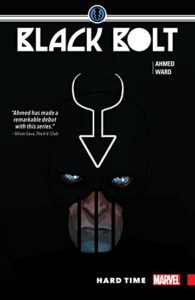
Black Bolt, Volume 1: Hard Time, written by Saladin Ahmed, illustrated by Christian Ward, lettered by Clayton Cowles (Marvel)
It wasn’t hard to predict that we’d see Saladin Ahmed on the ballot for this first volume collecting his popular and acclaimed run on Marvel’s Black Bolt. The titular King of the Inhumans wakes up in a prison somewhere in deep space, his powers suppressed, at the mercy of cruel jailers alternately Kafka-esque and Lovecraftian. He meets his fellow prisoners, and they decide to break out together.
Although the story is punctuated with the kind of action beats you’d expect — there are multiple “they fight, then team up” moments as Black Bolt meets and interacts with the rest of the cast — the story is remarkably and effectively quiet and low-key for a Marvel superhero comic. Ahmed gives us a great deal of Black Bolt’s inner life and inner voice, a novelty from a protagonist whose character is very much rooted in his inability to talk. And while some of that narrative skews a bit towards the Mighty Marvel bombastic, much of it is powerful and heartfelt, particularly the scenes between Black Bolt and Crusher Creel, sometimes known as the Absorbing Man.
Christian Ward’s art captures the characters very effectively, but sometimes suffers from the colour palette. I understand using colour to convey the oppressiveness of the setting, but found that the literal darkness sometimes obscured the action.
This is a strong, accessible, and surprisingly character-driven story that a reader not terribly familiar with current Marvel continuity (like me!) can jump right into. A very worthy nominee and well worth reading.
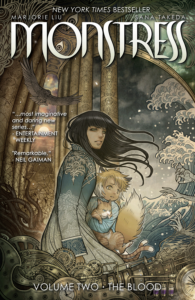
Monstress, Volume 2: The Blood, written by Marjorie M. Liu, illustrated by Sana Takeda (Image Comics)
Maika Halfwolf begins this second volume of Monstress seeking answers, and allies who will help her find them. Accompanying Maika are the fox child Kippa, the Machiavellian wizard (and cat) Master Ren, and the hideous, hungry outsider that she shares a body with. But never mind the answers; her questions, the places she’s willing to go and the things she’s ready to do to demand them, already threaten to split the world asunder, quite possibly literally.
I was pleased that Monstress Volume 1 won last year’s Best Graphic Story Hugo, but in a way, more for the idea of Monstress than the work itself. The book left me impressed, but perhaps a bit cold. Maika seemed a bit too much like yet another grimdark protagonist with a high body count. This volume, though, builds on the first one in a number of ways that pulled me in, as quickly and inexorably as the Elder God living inside Maika draws in its prey. We learn more about Maika’s past, and the pain that made her the person we see as the story continues to unfold. We learn some, but by no means all, of the secrets behind the broken, traumatized world and the factions that are pushing it towards further disaster.
I love that Liu isn’t afraid of words. This is a comparatively text-heavy comic, and it’s wonderful. Characters speak at length, not in quips, giving us a strong sense of their many and varied voices and personalities. But the dialogue does more than that, hinting at secret histories, unexamined corners of the setting, and unspoken motivations. There are appendices devoted to world-building and backstory, but the appendices themselves are from the viewpoint of a particular faction, for added levels of insight.
Takeda’s art is genuinely lovely, conveying the beauty and horror of an ancient and haunted world, a place of sorcerous steampunk torn apart by genocidal war and eldritch abominations both. The manga-inflected designs and characters are just as lovely and strange.
I am now fully on board for further instalments. My only caveat is that I wouldn’t want to try to read Monstress Volume 2 without having read Volume 1. It’s a testament to the work that I encourage you to read both.
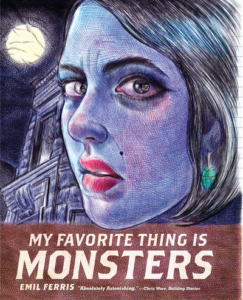
My Favorite Thing is Monsters, written and illustrated by Emil Ferris (Fantagraphics)
My Favorite Thing Is Monsters is a beautiful and profound work. It’s also a liminal work, arguably not SFF at all, which is why I originally didn’t think it was likely to be nominated. I’m very pleased that there were so many voters with a broad and inclusive view of what falls within the genre.
The cold Chicago spring in 1968, and 10-year-old Karen Reyes loves monsters. She fills her spiral-bound notebook with a deeply personal journal of her life, of monsters and monstrousness, of the slow tragedy that threatens to take away her mother, and her love of creature features. But when Karen’s beloved upstairs neighbour, a kind, deeply traumatized Holocaust survivor, dies under mysterious circumstances, Karen decides to investigate and solve the mystery. But the plot, while engaging, is only part of the appeal. The story is told through Karen’s eyes, her diary and her illustrations, all filtered through a prism of her only partial understanding of the world and the motivations of the adults around her, and also her love of monsters. Karen is depicted throughout as she imagines and draws herself, a sort of Lon Chaney-ish Wolfgirl, and the other characters and the setting shift, sometimes more realistically portrayed, sometimes cartoonish, sometimes as denizens of Famous Monsters of Filmland. Much of the art is black and white, but some is in blue ink, depending on the pens Karen is using, on pages that are designed to look like her notebooks. The lettering rambles across the page, in digressions and asides and labels. The book as a whole so brilliantly emulates the journal of a talented, precocious but sad and outcast child that I have to repeatedly remind myself that it isn’t a real historic artifact, and that Karen Reyes isn’t Emil Ferris.
This book, in short, is a remarkable achievement. It’s astonishing that such an outstanding graphic novel is Emil Ferris’s debut; her personal story in its own way as remarkable as the story she tells within its pages, and I recommend learning more about her, as well as unreservedly recommending that you read My Favorite Things Is Monsters. But I also strongly recommend that you read it as a print book; I can’t imagine trying to follow these pages, their nuance and detail and idiosyncratic layout, on a screen.
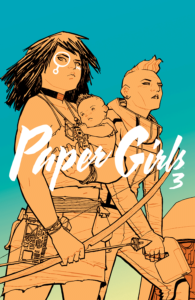
Paper Girls, Volume 3, written by Brian K. Vaughan, illustrated by Cliff Chiang, colored by Matthew Wilson, lettered by Jared Fletcher (Image Comics)
Brian K. Vaughan’s first of two nominations this year is for Volume 3 of his ongoing series Paper Girls. Mackenzie, Tiffany, KJ and “New Girl” Erin are the eponymous young women, who on November 1, 1988 just set out to deliver some newspapers, only to be caught up in a massive, time-travelling, reality-bending cascading crisis that threatens not only their lives but the entire fabric of history. And that was just the first volume. Complications ensued, and as this latest volume begins, the four protagonists are reunited, but trapped in the Neolithic. The good news is that they seem to have evaded the several factions of hostile time travelers who were after them. The bad news is that the fabric of space-time is tearing, and portals are opening up, making everything worse, and not just for them.
While it’s not my favourite of the nominees, this volume was the instalment that really got me invested in Paper Girls. It’s both more focused and goes deeper than the first and second books in the series. Volume 1 is more rooted in the ordinary world and does a lot of work setting things up; Volume 2 is wildly SFFnal but also initially feels like it’s approaching time travel lightly, and through familiar tropes — Erin meeting her future self and being deeply disappointed, for instance, is something we’ve seen explored in time travel stories before, mined for both comedy and drama. But later in that volume, shit gets very real, in ways that carry the narrative through Book 3 and its increasing danger and dread.
Vaughan’s dialogue tends to be banter-heavy, but it works in this story of four young women all working very hard to not be afraid. The characters continue to grow beyond being mere types, with KJ questioning both her cautious, play-it-safe philosophy and her sexuality and Mackenzie’s tough girl persona breaking down as she grapples with the revelation, from Volume 2, that she will die of cancer in only a few years. The plot is, well, it’s full of temporal weirdness, which is a given since this is Vaughan playing with a time travel narrative, but it seems to all be going somewhere, and I’m invested enough in the cast to want to know what happens to them.
Cliff Chiang’s art continues to capture the story’s four protagonists adeptly, as well as the growing supporting cast and the extremely varied settings, which range from mundane to fantastical.
Paper Girls Volume 3 will probably suffer from being the “other” Brian K. Vaughan comic on the ballot, but it’s smart and fun and a fine time-travel story.
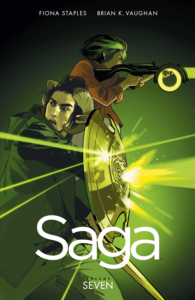
Saga, Volume 7, written by Brian K. Vaughan, illustrated by Fiona Staples (Image Comics)
Saga returns to the Hugo ballot with this, its seventh volume. Shameful confession time: I don’t follow Saga regularly. So I came to this book having read a couple of earlier volumes, not in sequence either. I was prepared for the weirdness. I wasn’t entirely prepared for the tragedy.
Hazel and her parents, Marko and Alana, are reunited but on the run from their warring planets, and it appears, most of the galaxy at this point. Seeking fuel and shelter, they and their friends (and some enemies) land on the inhabited comet Phang. They end up staying for a lot longer than planned, which gives their pursuers the opportunity to catch up, and things go very badly.
My impression of earlier instalments of Saga was of mayhem played rather more lightly, with emotional moments leavened with whimsy. Volume 7 doesn’t have a whole lot of leavening, and goes to very intense, frightening places. The protagonists remain believable, and continue to charm even as they face traumas old and new. Vaughan’s dialogue and narration are strong, although a bit quippy and on-the-nose about the points being made. But it’s an admirable achievement to shift the conflict from the earlier “how are they going to get out of this one?” to “how will they endure having lived through this tragedy?”
Fiona Staples continues to be brilliant, able to depict kinetic action and profound emotion, adorable space otter people and cosmic horrors — sometimes all within the confines of a single page.
Clearly, given how it drew me in, Volume 7 isn’t too late to get caught up with or engaged in Saga. Don’t let the growing backstory be a barrier to reading this very good and often moving book.
Conclusions? Nope.
Instead, I’m going to suggest you read, and draw your own.
My first draft of this piece had a long who-should-win vs. yeah-but-who-will-win segment, where I unpacked a whole big Best Graphic Story Hugo Kremlinology kind of take.
But on further reflection, I don’t want to do that. It got too far away from my focus — shining a spotlight on the good, to help bring wider attention to awesome works of comics SFF.
These works are all good. Some are great. All are worthy of wider readership, and I hope the Hugo nominations and my own thoughts here encourage more of you to seek them out, whether you’re voting for the Hugos or not.
Acknowledgements and Disclosures: I would like to acknowledge that Toronto, and the land it now occupies, where I live and work, has been a site of human activity for 15,000 years. This land is the traditional territory of the Huron-Wendat and Petun First Nations, the Seneca, and most recently, the Mississaugas of the Credit River. The territory was the subject of the Dish with One Spoon Wampum Belt Covenant, an agreement between the Iroquois Confederacy and Confederacy of the Ojibwe and allied nations to peaceably share and care for the resources around the Great Lakes. This territory is also covered by the Upper Canada Treaties. Today, the meeting place of Toronto is still the home to many Indigenous people from across Turtle Island. I am grateful to have the opportunity to live and work in the community of Toronto, on this territory.
I have no relationships that I’m aware of with the creators of publishers of any of these works. I obtained my own copies of the books, mostly via the library.

